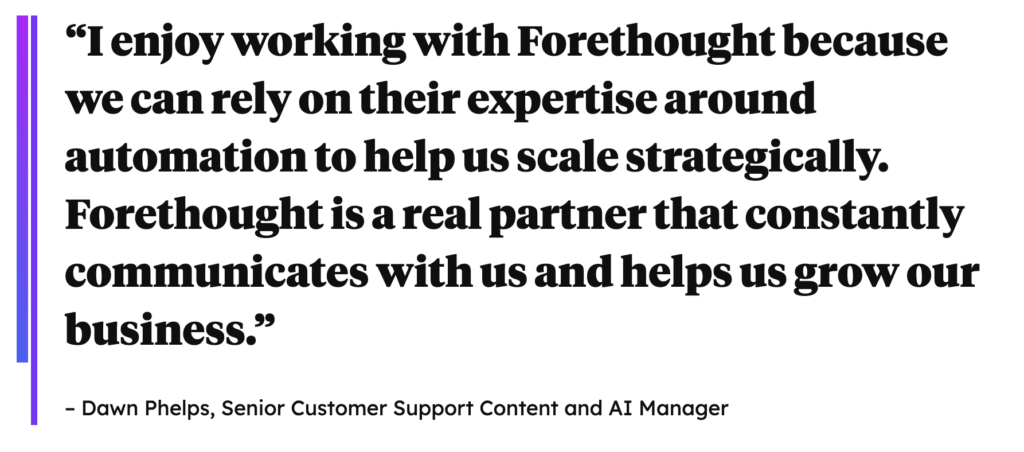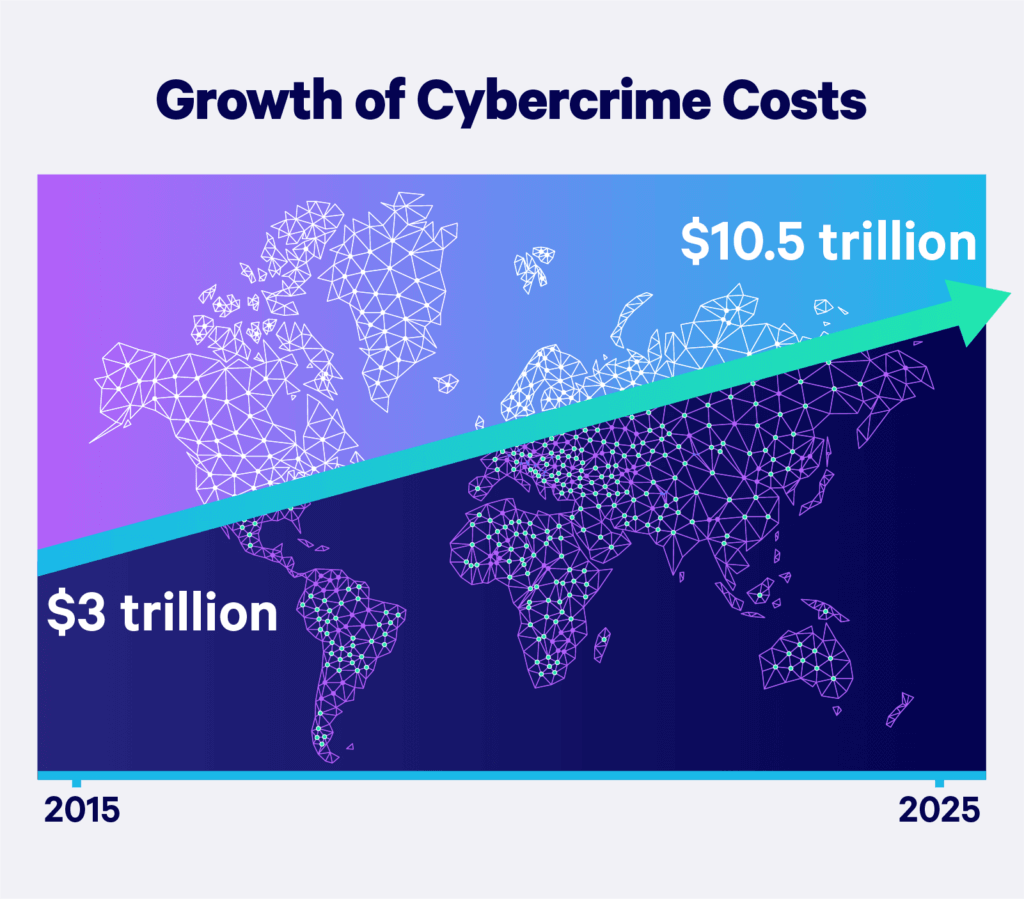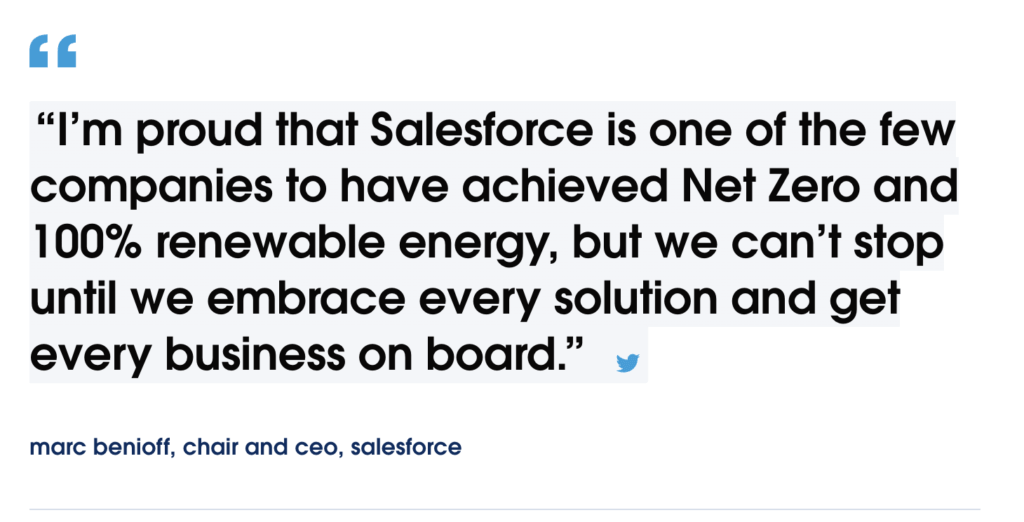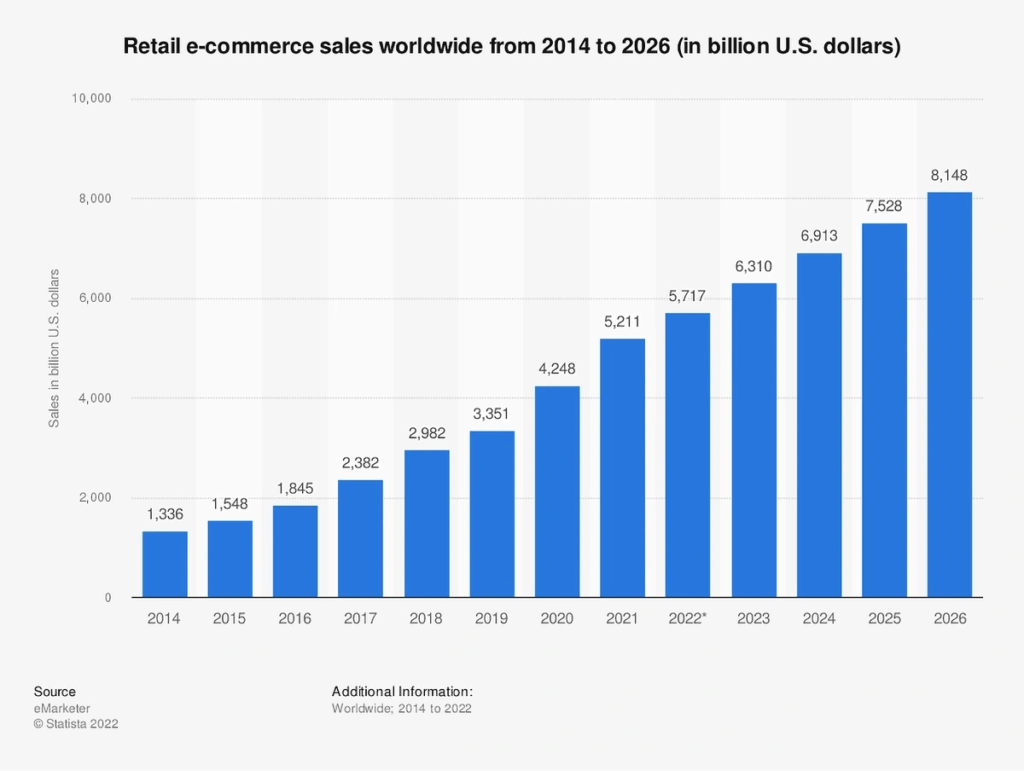With fast progress in AI, changes in how people buy things, and more automation, these changes are ready to create significant economic growth and new ideas. AI is changing industries by making them much more efficient, automation is changing how work gets done, and people’s changing buying habits are creating new market needs.
These forces are not just the business trends but pivotal elements shaping the future of business, creating vast potential for new business models and revenue streams.
Today’s businesses are in a constantly changing environment where staying informed and flexible is essential for success. Whether starting a new business or trying to stay ahead, exploring these business trends can give you helpful insights and strategies.
In this blog, we will discuss the top business trends shaping the future. These include the impact of AI, the importance of cybersecurity, the focus on sustainability, and advancements in e-commerce, 5G, 6G technologies, robotics, and automation.
Types Of Business Trends
1. Technological Trends
Technological advancements are driving significant changes across industries:
- Artificial Intelligence (AI): AI is revolutionizing operations from customer service through chatbots to predictive analytics in marketing. It enables businesses to analyze vast amounts of data and generate valuable insights.
- Cloud Computing: Cloud computing provides flexible computer resources that you can use according to your business needs. This enables you to scale your apps and services without purchasing and managing physical servers, reducing the need for expensive hardware.
- Blockchain: Blockchain technology is changing the financial world. It offers secure, decentralized transactions and smart contracts, increasing transparency, enhancing security, and reducing fraud.
You can use these technologies to optimize your business operations, improve customer experiences, and create new revenue streams.
2. Consumer Behavior Trends
Modern consumers increasingly favor sustainable business practices, driving a change in how companies operate.
- Demand for Eco-Friendly Products: Modern consumers prioritize eco-friendly products and ethical business practices.
- Green Initiatives: Companies are adopting green initiatives, such as reducing carbon footprints, using renewable energy, and ensuring supply chain transparency.
- Brand Loyalty: Aligning with consumer values helps build brand loyalty and attracts a broader customer base.
Sustainability contributes to environmental preservation and enhances financial performance by reducing waste and improving efficiency.
3. Finance Trends
The financial sector is experiencing rapid evolution influenced by technology and changing economic conditions:
- Fintech Innovations: Mobile banking, digital wallets, and robo-advisors make financial services more accessible and efficient. These tools offer personalized financial advice, streamline transactions, and improve investment management.
- Sustainable Finance: There is a growing emphasis on investing in environmentally and socially responsible projects. This financial trend appeals to a new generation of investors focused on sustainability and ethical investing.
7 Top Business Trends For 2025
1. Generative AI
Generative AI, powered by large language models (LLMs) like ChatGPT, has revolutionized how businesses operate, from automating customer service interactions to creating personalized marketing content. In 2025, it can significantly impact various industries, becoming one of the key business trends.
According to the Boston Consulting Group, generative AI will hold about 30% of the entire AI market by 2025, valued at roughly $60 billion.

The capabilities of AI models are rapidly expanding. Businesses are making customized “co-pilots” for fields like architecture, accounting, medicine, law, and education. These co-pilots enhance productivity by handling knowledge-based tasks, allowing humans to concentrate on more strategic and creative work.
Forethought is a leading AI startup in the customer service sector. Their AI solution offers support via chat, email, help desk, and social media.

In 2021, Forethought completed a $65 million Series C funding round, grew their ARR by 5x, and tripled their customer base. Recently, they worked with Lime, a company dedicated to providing sustainable, affordable transportation through its fleet of electric bikes and scooters.
Lime used Forethought’s AI solutions to automate and scale its customer support operations. Using Forethought Triage, Lime routed tickets to the right agents based on language and urgency, significantly improving response times.
With Forethought Solve, Lime automated responses to common inquiries, resulting in a 77% reduction in response time and automating 27% of cases. This improved customer satisfaction and helped save on costs.

In the customer service sector, Zendesk uses generative AI to enhance customer service through its AI-powered tool, Answer Bot. Answer Bot is designed to respond automatically to common customer inquiries using natural language processing (NLP). It helps in understanding customer queries and generate appropriate answers. This tool reduces response times and improves customer experience by providing instant support.
For instance, Medline Industries, a leading manufacturer and distributor of healthcare supplies, has integrated Zendesk across its operations to drive productivity and improve customer satisfaction. Medline uses Zendesk to handle over 800,000 tickets annually, with instances in their Distribution, Finance, HR, and Sales Operations divisions.
By leveraging Zendesk’s AI capabilities, Medline has seen a 52% increase in email productivity across three instances and a 5-7% overall productivity increase.
2. Cybersecurity
Cybersecurity will remain one of the most important business trends in 2025. Companies must use advanced security tools and regularly update protocols to avoid digital threats. According to recent research shows, 54% of small business owners are more concerned about data security than ever before.
That’s because modern threats have increased the use of malware, ransomware, and DDoS attacks, and therefore, organizations require a layered security approach. Threat actors, therefore, use multiple techniques concurrently to get their desired results, making it paramount for organizations to remain on the lookout for them.
Also, with the participation of actors from nation-states in cyber warfare and cyber espionage, it brought a new dimension to the threats. Organic cyber attack groups sponsored by various states are among the most notorious actors in recent years due to the targeted attacks on the critical infrastructure and the sensitive data having political or geopolitical relevance.

Moreover, it has been stated that by 2025, cybercrime is projected to cost businesses globally around $10.5 trillion each year, a significant increase from $3 trillion in 2015. With an annual growth rate of 15%, Cybersecurity Ventures highlights that cybercrime is the largest economic wealth transfer in history.
Businesses can focus on cybersecurity trends to innovate and create new ventures, making cybersecurity a strategic advantage rather than just a necessity.
One major concern is the shadow banking industry, which is less regulated than other national banks. It represents nearly half of the global assets and is considered a major systemic risk to the global economy. As per the FBI report, cybercrimes have surged by 300%.
Now, the question is how to deal with these emerging business trends.
To handle new cybersecurity challenges, businesses can invest in the latest security technologies (like Sprinto and Kali Linux) and have strong security policies. Regularly train employees on how to stay safe online. Work with cybersecurity experts and be proactive in finding and fixing security issues.
Conduct regular security checks, use data encryption tools, and keep your software updated. Having two-factor authentication, stringent vendor security protocols, virus and malware protection, and robust password policies are also fundamental measures that can help mitigate risks. Stay informed about the latest threats to protect your business’s data and assets effectively.
3. Sustainability and Eco-Friendly Practices
Sustainability remains a key business trend for firms to consider in 2025 because of continued consumer pressures for green goods and services. According to Visa’s Global Back to Business Study, 68% of consumers report that a company’s sustainability practices influence their purchasing decisions, and more than three out of four consumers are willing to pay more for sustainable products and services.
Salesforce has committed to achieving net-zero emissions throughout its operations and supply chain and has been seriously involved in assisting its buyers in minimizing their emissions. The Salesforce Sustainability Cloud is an informative platform that can help businesses address their sustainability performance and monitor the environmental effects of their operations.

Printify, a transparent print-on-demand and dropshipping platform, focuses on sustainable manufacturing through on-demand production, significantly reducing waste. Most of their partners use 100% biodegradable, toxin-free, water-based inks, and their international shipping is carbon neutral.
Printify is committed to reducing its environmental footprint by rethinking packaging options and minimizing the distance between print providers and end consumers, ensuring a more eco-friendly approach to business operations.

Businesses can implement several sustainability practices to meet consumer expectations and regulatory requirements. These include:
- Re-evaluating supply chains to minimize environmental impact by sourcing materials locally and reducing transportation emissions.
- Using eco-friendly packaging such as compostable materials to cut back on waste
- Adopting sustainable delivery methods, like using electric vehicles, to reduce carbon emissions.
Regulatory pressures are also increasing. Starting in 2024, the European Union’s Corporate Sustainability Reporting Directive (CSRD) will require companies to disclose their sustainability practices in detail.
The circular economy concept is gaining traction, as seen with Teemill, a UK-based fashion business that recycles returned t-shirts into new products. Teemill promotes a closed-loop system that minimizes waste.
Incorporating sustainability into business strategies meets regulatory demands and enhances brand reputation and customer loyalty.
4. E-commerce
E-commerce continues to grow post-pandemic, with global sales projected to reach $8.1 trillion by 2026. This sustained growth is due to changing consumption patterns, and people prefer to shop online, especially during the pandemic.

Klaviyo, a SaaS B2B company specializes in e-commerce marketing automation. Klaviyo provides businesses with powerful tools to automate email marketing, SMS campaigns, and personalized customer engagement.
By integrating with major e-commerce platforms like Shopify and BigCommerce, Klaviyo enables businesses to leverage customer data for targeted marketing efforts.
For example, the jewelry brand Catbird used Klaviyo to create personalized email campaigns based on customer behavior, resulting in a 60% increase in email-driven revenue and a 40% boost in customer engagement.
Technological advancements are crucial to the evolution of e-commerce. AI-powered solutions are enhancing customer experiences through personalized recommendations, dynamic pricing, and customer service chatbots.
For instance, AI can analyze a customer’s browsing and purchasing history to suggest products they are likely to buy, improving customer satisfaction and increasing sales. One great example of using this technology is Amazon. A McKinsey study reveals that AI recommendation algorithms drive over 35% of Amazon’s sales.

Social commerce is also on the rise in e-commerce, where buyers are using social media platforms as shopping platforms. Companies use Instagram and TikTok for D2C marketing and influencer, sponsored, and ad posts. This has taken root, especially in the fashion, beauty, and home decoration categories.
Also, the Augmented Reality (AR) and the Virtual Reality (VR) have become an essential part of e-commerce. Services like those offered by Pinterest have added features. They let people test products like furniture and makeup before buying. This improves the shopping experience, which thus boosts consumption and sales among the consumers. Research has shown that consumers who use AR to try products are far more likely to buy than those who do not.
5. 5G and 6G Development
To thrive in all the above business trends, we can’t forget the core of it. Without better internet speed, we can’t do anything much around technology. 5G technology is already enhancing businesses’ productivity. 6G research has already started, and it’s projected to come in 2030 for commercial uses.
5G is set to become widespread in 2025, boosting data speeds, dependability, and networking. Hence, leading the way for 6G. These advancements meet the growing demand for fast connectivity essential for modern businesses. This robust internet supports seamless remote work and technologies like AI, AR, and VR, driving new business developments.
Compared to the 4G networks, 5G delivers much higher data, rates, and much lower latency, which is helpful for organizations that require the use of real-time data and automation. For instance, BMW has adopted 5G to optimize production lines and enhance the safety of employees through its integration with AI to identify with significant precision the location of machines, automobiles, tools, and components in real time. This integration helps in increasing efficiency.
Nokia is among the SaaS industry leaders that apply 5G technology. Nokia offers both standalone and integrated end-to-end 5G solutions for enterprises to build private 5G networks that provide better connectivity to increase IoT business application and operational performance. Their solutions are used in various industries, including manufacturing, logistics, and healthcare. They help in driving innovation and productivity through advanced wireless technology.
Another notable example is Ericsson, which provides comprehensive 5G solutions for enterprises. Ericsson’s latest enhancements to their premier private network solution, Ericsson Private 5G, are designed to support industrial digitalization for Industry 4.0.
These upgrades include improved visibility and management, increased coverage, and enhanced security. The solution now offers over 1,000,000 square meters coverage with click-to-deploy functionality, making it ideal for complex environments like manufacturing, ports, and energy sectors.
Ericsson Private 5G enables manufacturers to achieve higher levels of automation, agility, and safety in their operations. For instance, Nestlé Brazil has implemented this solution to simplify its factory environment and connect many devices to a secure, reliable network. This deployment is part of a broader effort to accelerate digital transformation, reduce costs, and increase efficiencies across various industries.
The future development of 6G technology promises even greater advancements. 6G is expected to offer ultra-low latency, increased reliability, and the ability to support many connected devices simultaneously. This will enable new applications such as holographic communications, advanced robotics, and seamless virtual and physical world integration.
6. Remote Work
The trend towards remote work, accelerated by the COVID-19 pandemic, continues to shape businesses in 2025. While the initial shift to remote work was driven by necessity, many companies and employees have discovered the long-term benefits of flexible work arrangements.

A FlexJobs survey found that 96% of employees want to work remotely at least part of the time. This preference for remote work is not just about avoiding the commute; it’s about achieving a better work-life balance and increased productivity. Companies offering remote work options will likely see higher employee satisfaction and retention rates.
One company embracing this trend is Scilife, a fully remote tech startup with employees worldwide. By being 100% remote, Scilife has been attracting top talent without the constraints of geographical location while also saving on office space and utilities.

However, remote work is not without its challenges. Businesses must invest in collaboration and communication tools to keep teams connected and productive. Developing clear remote work policies is essential to ensure everyone understands expectations and maintains a healthy work-life balance.
Hybrid work models, which combine remote and in-office work, are becoming increasingly popular. According to a Gallup survey, 50% of employees with jobs that can be done remotely are on a hybrid schedule, while 30% work fully remotely. This model offers the flexibility of remote work while maintaining the benefits of in-person collaboration.

Despite the benefits, some employers remain concerned about productivity in a remote work environment. Microsoft’s Work Trend Index reports that 85% of business leaders find having confidence in employee productivity when working remotely challenging.
To ensure accountability, many companies are turning to monitoring technologies, such as screen monitoring and keystroke recording.
7. Robotics And Automation
There is no doubt that robotics and automation are transforming industries by improving efficiency, reducing costs, and enhancing precision.
Automation has seen a significant increase in demand. Between 2020 and 2022, automation tools increased by over 90%, saving businesses up to 109 billion monthly hours.
This minimises repetition and time wastage among employees, allowing them to engage in more productive work. The manufacturing, logistics, and healthcare industries are adopting automation to enhance their operations.
In the manufacturing industry, robots can work within the assembly line, performing visioning and inspection.
For example, UiPath offers a leading robotic process automation (RPA) platform that helps businesses automate repetitive tasks across various functions, such as finance, HR, and customer service. UiPath’s platform uses software robots to perform tasks like data entry, invoice processing, and customer support, which enhances accuracy and speed while freeing up human workers for more strategic roles.
For instance, the University of Auckland implemented UiPath’s RPA solution to enhance staff and student experiences. Initially aimed at cost savings, the RPA initiative automated processes like student transcript requests and supplier setup, saving 23,000 hours annually and achieving a 99% success rate in financial processes.
This improved service quality and allowed staff to focus on more valuable tasks. The success of this initiative also led to the creation of an RPA course, preparing students for the future of work in automation.
Automotive logistics companies are also not left out in the trend of automation. Automated systems independently suggest optimal routes and stock levels and estimate the delivery time, making the process better.
LogiNext, a logistics management firm, uses AI to automate route optimization and capacity utilization, significantly enhancing their last-mile delivery operations.
Healthcare is another sector experiencing the benefits of robotics and automation. Surgical robots, for instance, assist in performing complex procedures with greater precision and control than human surgeons alone.
Automated hospital systems manage patient records, schedule appointments, and monitor patient vitals, freeing up medical professionals to focus on patient care.
Conclusion
As we look to the future, understanding new business trends in 2025 is important for success. The increase in new business opportunities shows how the market is changing.
With trends like AI, cybersecurity, sustainability, and advancements in e-commerce, AR/VR, and 5G, businesses can improve their work. Following these new business trends can help you tackle existing challenges, find new business opportunities, and thrive in your industry.
Explore My Other Articles:
1. Top 10 Lead Generation Strategies for B2B SaaS business
2. 11 Benefits of Automated Invoice Processing
3. Leveraging Customer Data For Targeted SaaS Growth
4. 10 Must-Have AI Voice Generator Tools For 2025
5. Best E-commerce Tools For Businesses In 2025
6. 50+ Online Shopping Stats & Trends In 2025



